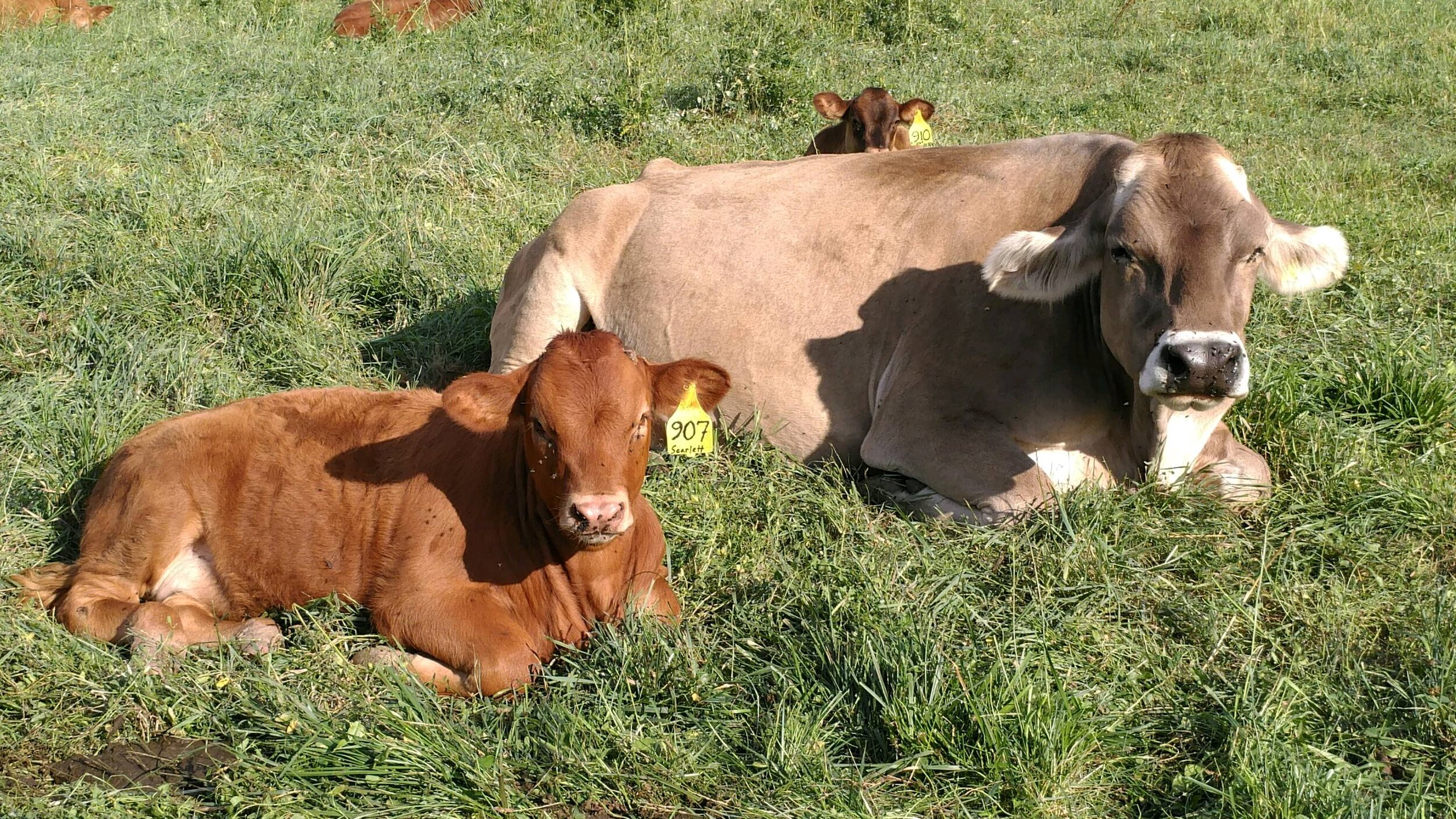Cows grazing on pasture at Saint John’s Organic Farm.
When purchasing meat, we have many options that seem similar. At the grocery store, labels like “pasture raised”, “all natural”, “grass fed”, “naturally raised”, and “organic” abound. All of these evoke an image of happy cows spending their days grazing on green grass. The truth is often contrary to that idyllic image because not all beef is raised well. Some of the aforementioned meat labels are regulated and some allow for surprising caveats. Here’s what you need to know.
What is Grain Fed Beef?
Most grocery store beef comes from cows that are raised on large feedlots called concentrated animal feeding operations (CAFOs). In CAFOs, cows are crowded, confined, and fed a grain-based feed, typically consisting of soy and corn. It’s common to supplement their diet with small amounts of dried grass.
In the US, most beef is grain fed. Almost all cows begin life with mother’s milk and grazing grass for the first months of life. After that, most young cows are transferred to a feedlot to finish growing on a grain-based diet, and they are sometimes supplemented with dried grass.
The saying “you are what you eat” applies to cows as well as people. Cows were meant to eat grass and have room to roam and graze. Cows raised on CAFOs are routinely given antibiotics and steroid hormones to maximize growth and profit. The beef harvested from these animals is nutritionally inferior to Organic, grass fed and finished beef.
What is Grass Fed Beef?
The USDA no longer regulates the term “grass fed”. If the cow ate some grass at some point in its life, the beef from that cow can have “grass fed” on the label, as “grass fed” is mostly an unregulated term. There are some independent, third-party grass fed certifications popping up, and they all have different requirements and standards.
Technically, almost all beef is grass fed beef because most cows in US farms graze some grass when nursing with their mothers in the early weeks and months of their lives. It’s the “finishing”, or what they eat after weaning, that matters. 99% of beef raised in the US is grain-finished or supplemented with grain. To complicate matters further, corn is botanically classified as a grass. Our farm is part of the 1% that raises exclusively grass-fed and grass-finished beef.
The grass fed label may mean that the cow was mostly raised on grass or it may mean the cow was raised in confinement with grain and hay. It’s simply unclear. The grain diet or grain supplemented diet causes cattle to gain excess fat and leads to depletion of various nutrients in the final beef product.
For the average package of grass fed beef from the supermarket, we don’t know how the cow was raised, whether it was injected with hormones or antibiotics, or what it ate. This highlights why it is important to know and talk to your farmers. Ask questions to know what you are purchasing.
Additionally, avoid the most inexpensive “grass fed” beef from the grocery store because it was likely imported, as Congress has eliminated Country of Origin labelling. Imported meat is more likely to come from animals raised in confinement and supplemented with grain.
Young, Brown Swiss cows curiously looking out.
What is Organic, Grass Fed, Grass Finished Beef?
Fully grass fed, grass finished beef accounts for less than 1% of all beef raised in the US.
Cows that are 100% grass fed and grass finished spend their days grazing in pastures, where they eat a variety of grasses, clover, and other healthful plant matter. They are commonly supplemented with hay in the winter. They are not supplemented with grain and have access to pasture year-round.
Organic is a heavily-regulated term from the USDA. Beef labelled organic will be free of antibiotics, hormones, and synthetic pesticides, herbicides, or fertilizers. It’s worth noting that beef can be labeled organic without being grass fed and grass finished. Organic beef can be mostly grain fed or grain supplemented, as long as the grain is organic.
It’s important to look for all three: organic, grass fed, grass finished.
Conventional Beef vs. 100% Organic Grass Fed Grass Finished: Nutritional Differences
Compared to conventional grain-fed beef, organic, grass-fed and grass-finished beef is:
10X higher in vitamin A
3X higher in vitamin E
Substantially higher in calcium, magnesium, potassium, & B vitamins
Lower in cholesterol
An abundant source of anti-cancer conjugated linoleic acid
Free of GMOs
Free of synthetic fertilizers
Free of hormones and antibiotics
Free of glyphosate and other pesticides or herbicides
Cows at Saint John’s Organic Farm.
We provide organic, grass fed, and grass finished beef because it’s best for the animal’s health, quality of life, and for our own health. We know that this is a sustainable way to feed our community, and we use regenerative practices to steward our land. As an added bonus, the meat’s flavor is more complex and enjoyable!













